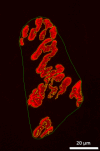Mature and Juvenile Neuromuscular Plasticity in Response to Unloading
- PMID: 40343402
- PMCID: PMC12060605
- DOI: 10.1002/dneu.22966
Mature and Juvenile Neuromuscular Plasticity in Response to Unloading
Abstract
The neuromuscular junction (NMJ) is the synapse that enables the requisite electrical communication between the motor nervous system and the myofibers that respond to such electrical stimulation with movement and force development. Changes in an NMJ's normal activity pattern have been demonstrated to remodel both the synapse and the myofibers that comprise the NMJ. Significant amounts of research have been devoted to the study of aging on the neuromuscular system. Far less, however, has been focused on revealing the effects of reduced activity on the NMJ and myofibers comprising juvenile neuromuscular systems. In the present investigation, the consequences of decreased activity imposed by muscle unloading (UL) via hindlimb suspension for 2 weeks (a period known to induce muscle remodeling) were examined in both young adult, that is, mature (8 mo), and juvenile (3 mo) neuromuscular systems. In total, 4 treatment groups comprised of 10 animals (Juvenile-Control, Juvenile-Unloaded, Mature-Control, and Mature-Unloaded) were studied. Immunofluorescent procedures, coupled with confocal microscopy, were used to quantify remodeling of both the pre- and postsynaptic features of NMJs, as well as assessing the myofiber profiles of the soleus muscles housing the NMJs of interest. Results of ANOVA procedures revealed that there were significant (p < 0.05) main effects for both treatment, whereby UL consistently led to expanded size of the NMJ, and Age where expanded NMJ dimensions were consistently linked with mature compared to juvenile neuromuscular systems. Moreover, only sporadically was interaction between the main effects of Age and Treatment noted. Importantly, one variable that remained impressively resistant to the effects of both Age and Treatment was the critical parameter of pre- to postsynaptic coupling suggesting stability in effective communication at the NMJ throughout the lifespan and despite changes in activity patterns. The data presented here suggest that further inquiry must be performed regarding disuse-related plasticity of the neuromuscular system in adolescent individuals as those individuals regularly suffer injuries resulting in periods of muscle UL.
Keywords: adolescence; aging; atrophy; disuse; synapse.
© 2025 The Author(s). Developmental Neurobiology published by Wiley Periodicals LLC.
Conflict of interest statement
The authors declare no conflicts of interest.
Figures






Similar articles
-
Home treatment for mental health problems: a systematic review.Health Technol Assess. 2001;5(15):1-139. doi: 10.3310/hta5150. Health Technol Assess. 2001. PMID: 11532236
-
Sertindole for schizophrenia.Cochrane Database Syst Rev. 2005 Jul 20;2005(3):CD001715. doi: 10.1002/14651858.CD001715.pub2. Cochrane Database Syst Rev. 2005. PMID: 16034864 Free PMC article.
-
Abnormalities in the genioglossus muscle and its neuromuscular synapse in leptin-deficient male mice.Skelet Muscle. 2025 Jul 5;15(1):18. doi: 10.1186/s13395-025-00387-1. Skelet Muscle. 2025. PMID: 40616148 Free PMC article.
-
Signs and symptoms to determine if a patient presenting in primary care or hospital outpatient settings has COVID-19.Cochrane Database Syst Rev. 2022 May 20;5(5):CD013665. doi: 10.1002/14651858.CD013665.pub3. Cochrane Database Syst Rev. 2022. PMID: 35593186 Free PMC article.
-
Psychological and/or educational interventions for the prevention of depression in children and adolescents.Cochrane Database Syst Rev. 2004;(1):CD003380. doi: 10.1002/14651858.CD003380.pub2. Cochrane Database Syst Rev. 2004. Update in: Cochrane Database Syst Rev. 2011 Dec 07;(12):CD003380. doi: 10.1002/14651858.CD003380.pub3. PMID: 14974014 Updated.
References
-
- Alford, E. K. , Roy R. R., Hodgson J. A., and Edgerton V. R.. 1987. “Electromyography of Rat Soleus, Medial Gastrocnemius, and Tibialis Anterior During Hind Limb Suspension.” Experimental Neurology 96, no. 3: 635–649. - PubMed
-
- Anderton, B. H. , Breinburg D., Downes M. J., et al. 1982. “Monoclonal Antibodies Show That Neurofibrillary Tangles and Neurofilaments Share Antigenic Determinants.” Nature 298, no. 5869: 84–86. - PubMed
-
- Andonian, M. H. , and Fahim M. A.. 1989. “Nerve Terminal Morphology in C57BL/6NNia Mice at Different Ages.” Journal of Gerontology 44, no. 2: B43–B51. - PubMed
-
- Balice‐Gordon, R. J. , Breedlove S. M., Bernstein S., and Lichtman J. W.. 1990. “Neuromuscular Junctions Shrink and Expand as Muscle Fiber Size Is Manipulated: In Vivo Observations in the Androgen‐Sensitive Bulbocavernosus Muscle of Mice.” Journal of Neuroscience Official Journal Society Neuroscience 10, no. 8: 2660–2671. - PMC - PubMed
Publication types
MeSH terms
Grants and funding
LinkOut - more resources
Full Text Sources
Medical

